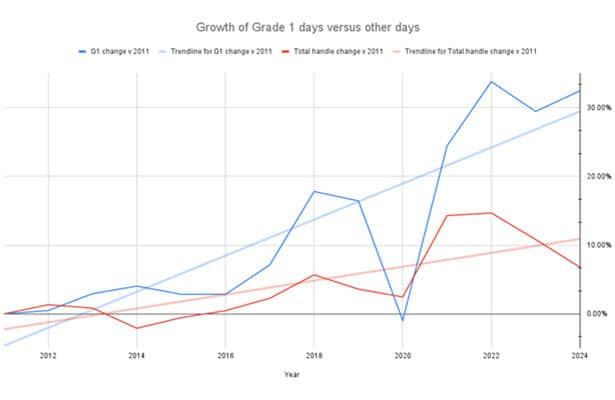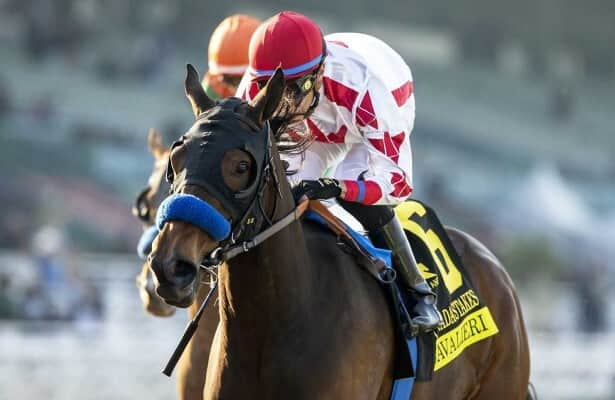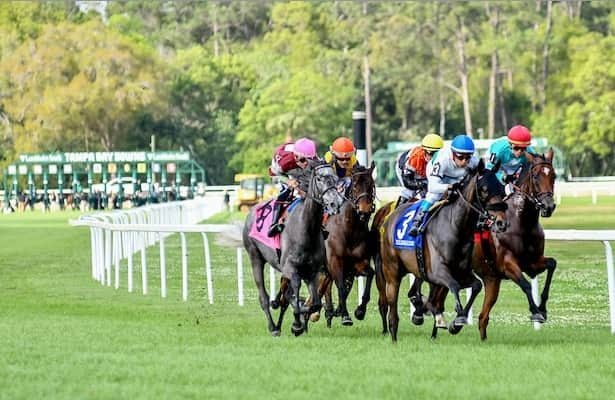By the numbers: North America needs more Grade 1 races

The wagering public, whatever is left of it, has spoken. It likes to bet Grade 1 races most, so North American Thoroughbred racing should offer more Grade 1 races.
Listen, no one has raged against the American Graded Stakes Committee machine more than I have. But the reality is that it and Churchill Downs Inc., by controlling the Kentucky Derby points system, hold the biggest carrots to get casual horseplayers to wager.
The number of Grade 1 races has declined 17.1% since 2011, when 117 Grade 1 events took place compared to 97 last year. But total handle on such races is up 46.8%, and the average handle is up 77.1%. All other races are up just 4.7% with average up 55.7%.
| Year | G1 races | Average field | Intra-race handle | Per race |
|---|---|---|---|---|
| 2024 | 97 | 8.90 | $791,479,916 | $8,159,587 |
| 2023 | 102 | 8.70 | $750,540,576 | $7,358,241 |
| 2022 | 105 | 8.45 | $777,063,075 | $7,400,601 |
| 2021 | 106 | 8.51 | $744,107,523 | $7,019,882 |
| 2020 | 98 | 8.23 | $521,901,758 | $5,325,528 |
| 2019 | 110 | 8.65 | $724,190,744 | $6,583,552 |
| 2018 | 113 | 9.18 | $717,382,545 | $6,348,518 |
| 2017 | 112 | 8.96 | $637,527,976 | $5,692,214 |
| 2016 | 114 | 8.99 | $623,184,562 | $5,466,531 |
| 2015 | 114 | 9.01 | $653,534,300 | $5,732,757 |
| 2014 | 114 | 8.87 | $655,471,805 | $5,749,753 |
| 2013 | 116 | 8.87 | $588,300,254 | $5,071,554 |
| 2012 | 117 | 8.60 | $573,662,175 | $4,903,096 |
| 2011 | 117 | 8.84 | $539,086,600 | $4,607,578 |
From a market-share perspective, Grade 1 races accounted for 4.8% of handle in 2011 and a record 6.7% last year. For the purposes of this research, only intra-race wagering such win-place-show, exacta and trifecta are consider, though I also will look at full cards.
| Year | G1 intra-race handle | Total annual intra handle | G1 % of total |
|---|---|---|---|
| 2024 | $791,479,916 | $11,029,635,143 | 6.70% |
| 2023 | $750,540,576 | $11,514,493,542 | 6.12% |
| 2022 | $777,063,075 | $11,916,672,416 | 6.12% |
| 2021 | $744,107,523 | $11,908,540,187 | 5.88% |
| 2020 | $521,901,758 | $10,821,818,610 | 4.60% |
| 2019 | $724,190,744 | $10,743,003,295 | 6.32% |
| 2018 | $717,382,545 | $10,980,664,195 | 6.13% |
| 2017 | $637,527,976 | $10,682,770,848 | 5.63% |
| 2016 | $623,184,562 | $10,496,548,812 | 5.60% |
| 2015 | $653,534,300 | $10,353,621,105 | 5.94% |
| 2014 | $655,471,805 | $10,179,721,679 | 6.05% |
| 2013 | $588,300,254 | $10,567,230,256 | 5.27% |
| 2012 | $573,662,175 | $10,639,420,616 | 5.12% |
| 2011 | $539,086,600 | $10,527,461,230 | 4.87% |
There were 54 Grade 1 days in 2024, days in which a racetrack conducted a Grade 1 race. A day such as Florida Derby and Arkansas Derby day counts as two days because both Gulfstream and Oaklawn Parks played host to Grade 1 races. Those 54 days handled a total of $1,802,938,517 for an average of $33,387,750. That is stark contrast to 2011, when 75 Grade 1 days handled $1,361,326,375 with a $18,151,018 average.
| Year | G1 1 days | G1 days handle | Avg G1 handle | Total annual handle | G1 % of day handle |
|---|---|---|---|---|---|
| 2024 | 54 | $1,802,938,517 | $33,387,750 | $11,824,476,754 | 15.25% |
| 2023 | 55 | $1,762,071,862 | $32,037,670 | $12,270,944,523 | 14.36% |
| 2022 | 58 | $1,821,135,017 | $31,398,880 | $12,697,209,092 | 14.34% |
| 2021 | 57 | $1,693,699,365 | $29,714,024 | $12,655,379,799 | 13.38% |
| 2020 | 54 | $1,348,360,799 | $24,969,644 | $11,345,650,447 | 11.88% |
| 2019 | 58 | $1,585,029,895 | $27,328,102 | $11,471,536,821 | 13.82% |
| 2018 | 63 | $1,603,628,347 | $25,454,418 | $11,701,599,078 | 13.70% |
| 2017 | 61 | $1,458,468,279 | $23,909,316 | $11,324,868,809 | 12.88% |
| 2016 | 60 | $1,400,053,119 | $23,334,219 | $11,124,335,855 | 12.59% |
| 2015 | 60 | $1,400,053,119 | $23,334,219 | $11,012,882,669 | 12.71% |
| 2014 | 65 | $1,416,330,890 | $21,789,706 | $10,840,975,268 | 13.06% |
| 2013 | 68 | $1,401,325,446 | $20,607,727 | $11,165,407,989 | 12.55% |
| 2012 | 69 | $1,367,949,544 | $19,825,356 | $11,220,671,418 | 12.19% |
| 2011 | 75 | $1,361,326,375 | $18,151,018 | $11,073,097,337 | 12.29% |
In the mid-2010s, the concept of a big event day expanded beyond the Breeders’ Cup to include more Grade 1 races on Kentucky Oaks, Kentucky Derby, Belmont Stakes, Travers Stakes and Pegasus World Cup days, but the average number of Grade 1 races on Grade 1 days has held steady at around 1.8.
I also looked at Grade 1 races outside New York, Kentucky and California to mitigate the effect of the sport’s biggest days, such as Derby and Breeders’ Cup, and the numbers are nearly identical. Wherever the Grade 1 is, bettors prefer it to any other type of race. In a sport otherwise in decline, Grade 1 races are a very obvious growth spot.
So, the solution is simple, more Grade 1 races. And they don’t have to come with overall graded-stakes bloat. Not much separates Grade 2 and 3 races in the eyes of the public, so I would move to a binary Grade 1 or graded system. This basically makes the pecking order Grade 1, then graded, then listed.
If there were 70 Grade 1 days with 105 Grade 1 races, handle on those days could top $2.5 billion without much erosion on other days for a 5% lift in total handle.
This would also allow some jurisdictions to return Grade 1 races that have been tacked on to even bigger days to their glory as headline events, such as the Met Mile. In other words, one Grade 1 has more value to a card that has none than a fifth Grade 1 would have to a card with four.
In this information age, the graded-stakes system has outlived its usefulness for breeders and sales catalogs. But it still has utility for informing the public of our best events, and that is why there should be more of them.
Related
Leading Parx jockey Sanchez will serve 7-day suspension
Photo: Jason Moran / Eclipse Sportswire Jockey Mychel Sanchez will serve a seven-day suspension and pay an additional $1,750 in fines
Bill Mott talks about plans for Sovereignty, Just F Y…
Photo: Gulfstream Park / Lauren King Sovereignty, dramatic late-running winner of the Fountain of Youth (G2) March 1, is being pointed
Up-and-coming Cavalieri chases Grade 1 glory in Beholder Mile
Photo: Santa Anita / Benoit Photo Cavalieri and Alpha Bella, who finished one-two in the Grade 3 La Cañada in January at Santa Anita,
4 stakes showcase shipping stars on Tampa Bay undercard
Photo: Gonzalo Anteliz Jr. / Eclipse Sportswire The stars will shine Saturday at Tampa Bay Downs, and not just in the Grade 3 Tampa Ba











